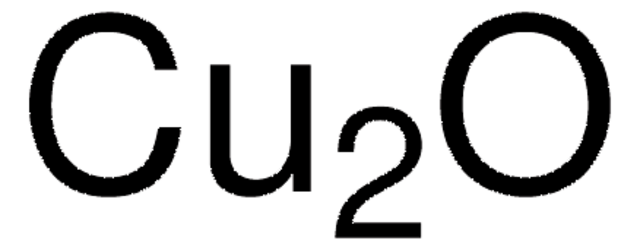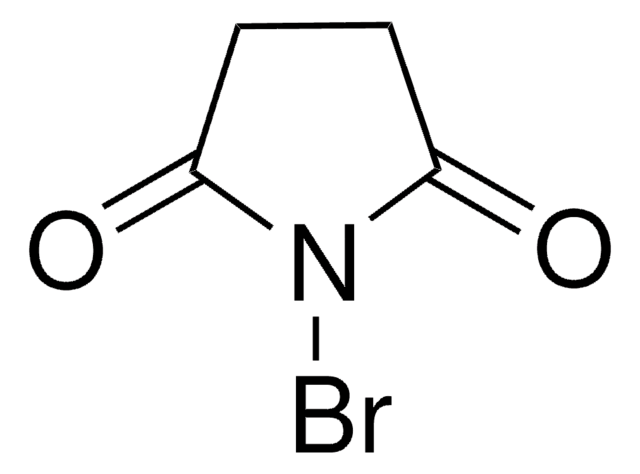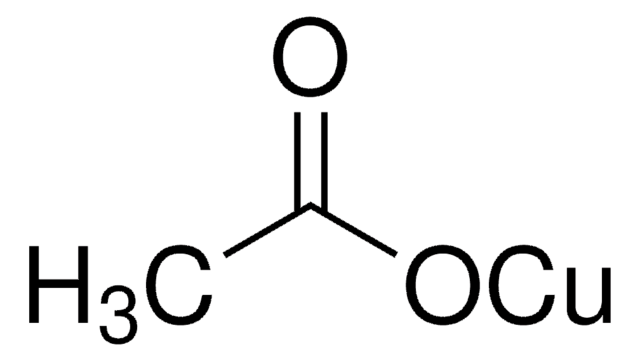Kluczowe dokumenty
229628
Copper(I) chloride
≥99.995% trace metals basis
Synonim(y):
Copper monochloride, Cuprous chloride
About This Item
Polecane produkty
klasa czystości
for analytical purposes
Poziom jakości
ciśnienie pary
1.3 mmHg ( 546 °C)
Próba
≥99.995% trace metals basis
Formularz
powder
przydatność reakcji
reagent type: catalyst
core: copper
metody
mass spectrometry (MS): suitable
zanieczyszczenia
≤50.0 ppm Trace Rare Earth Analysis
bp
1490 °C (lit.)
mp
430 °C (lit.)
rozpuszczalność
slightly soluble 0.47 g/L at 20 °C
Zastosowanie
battery manufacturing
ciąg SMILES
Cl[Cu]
InChI
1S/ClH.Cu/h1H;/q;+1/p-1
Klucz InChI
OXBLHERUFWYNTN-UHFFFAOYSA-M
Szukasz podobnych produktów? Odwiedź Przewodnik dotyczący porównywania produktów
Opis ogólny
Zastosowanie
Shows unique character as an initiator of radical reactions such as the hydrostannation of α,β-unsaturated ketones.
Hasło ostrzegawcze
Danger
Zwroty wskazujące rodzaj zagrożenia
Zwroty wskazujące środki ostrożności
Klasyfikacja zagrożeń
Acute Tox. 4 Dermal - Acute Tox. 4 Oral - Aquatic Acute 1 - Aquatic Chronic 1 - Eye Dam. 1 - Skin Irrit. 2
Kod klasy składowania
8A - Combustible corrosive hazardous materials
Klasa zagrożenia wodnego (WGK)
WGK 3
Temperatura zapłonu (°F)
Not applicable
Temperatura zapłonu (°C)
Not applicable
Środki ochrony indywidualnej
dust mask type N95 (US), Eyeshields, Faceshields, Gloves
Wybierz jedną z najnowszych wersji:
Masz już ten produkt?
Dokumenty związane z niedawno zakupionymi produktami zostały zamieszczone w Bibliotece dokumentów.
Klienci oglądali również te produkty
Produkty
Oxidation and reduction reactions are some of the most common transformations encountered in organic synthesis
Thermoelectric Performance of Perovskite-type Oxide Materials
Spectral conversion for solar cells is an emerging concept in the field of photovoltaics, and it has the potential to increase significantly the efficiency of solar cells. Lanthanide ions are ideal candidates for spectral conversion, due to their high luminescence efficiencies and rich energy level structure that allows for great flexibility in the upconversion and downconversion of photons in a wide spectral region (NIR-VIS-UV).
We presents an article about a micro review of reversible addition/fragmentation chain transfer (RAFT) polymerization. RAFT (Reversible Addition/Fragmentation Chain Transfer) polymerization is a reversible deactivation radical polymerization (RDRP) and one of the more versatile methods for providing living characteristics to radical polymerization.
Protokoły
We presents an article featuring procedures that describe polymerization of methyl methacrylate and vinyl acetate homopolymers and a block copolymer as performed by researchers at CSIRO.
Sigma-Aldrich presents an article about RAFT, or Reversible Addition/Fragmentation Chain Transfer, which is a form of living radical polymerization.
Global Trade Item Number
| SKU | GTIN |
|---|---|
| 229628-100G | 4061833595718 |
| 229628-10G | 4061838781963 |
Nasz zespół naukowców ma doświadczenie we wszystkich obszarach badań, w tym w naukach przyrodniczych, materiałoznawstwie, syntezie chemicznej, chromatografii, analityce i wielu innych dziedzinach.
Skontaktuj się z zespołem ds. pomocy technicznej








